Importance of Leadership and Team Dynamics: Reflective Essay
VerifiedAdded on 2023/06/10
|9
|3295
|147
AI Summary
This reflective essay highlights the importance of leadership and team dynamics in any organization. It discusses the author's personal experiences and learnings from an educational trip. The essay also covers the importance of feedback, communication, and conflict resolution in a team.
Contribute Materials
Your contribution can guide someone’s learning journey. Share your
documents today.
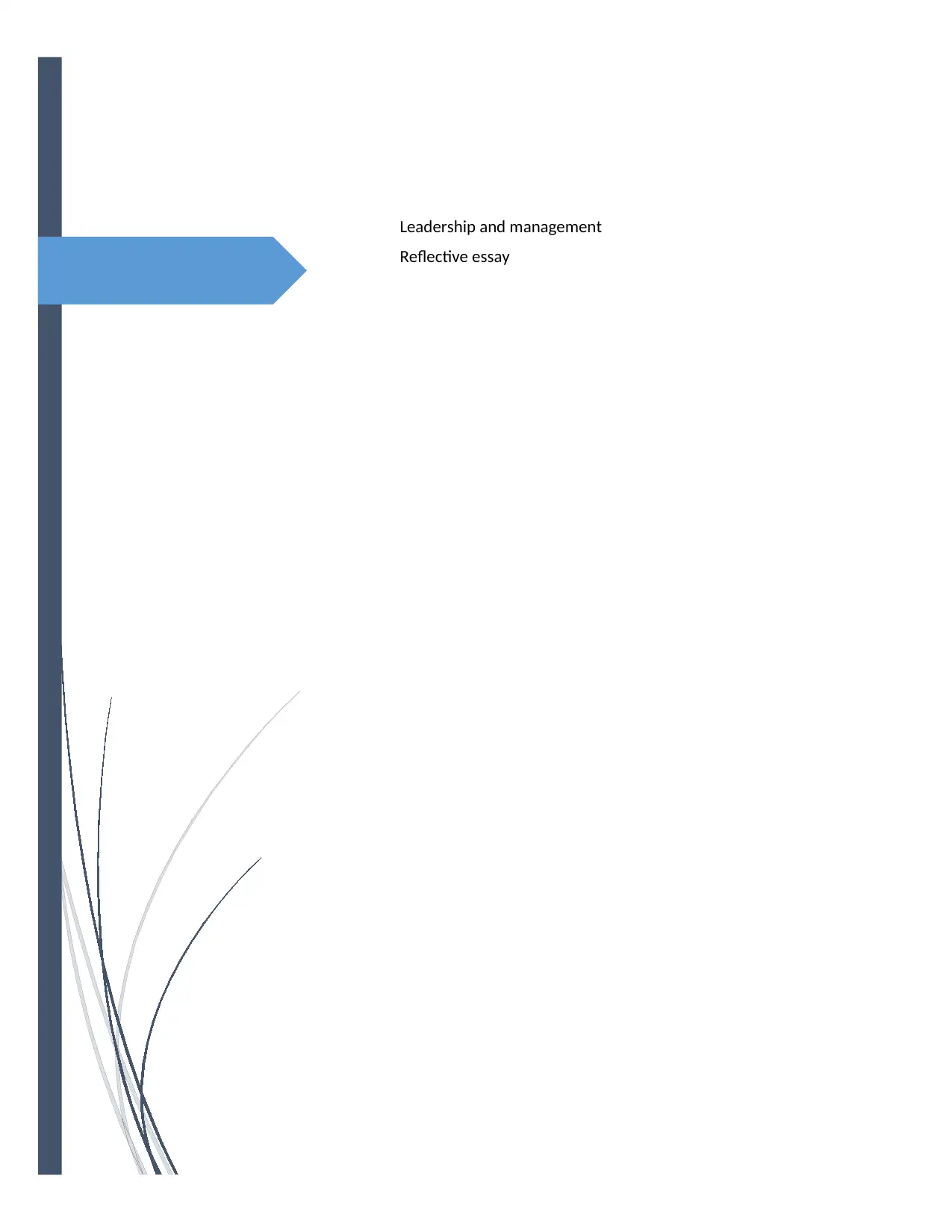
Leadership and management
Reflective essay
Reflective essay
Secure Best Marks with AI Grader
Need help grading? Try our AI Grader for instant feedback on your assignments.
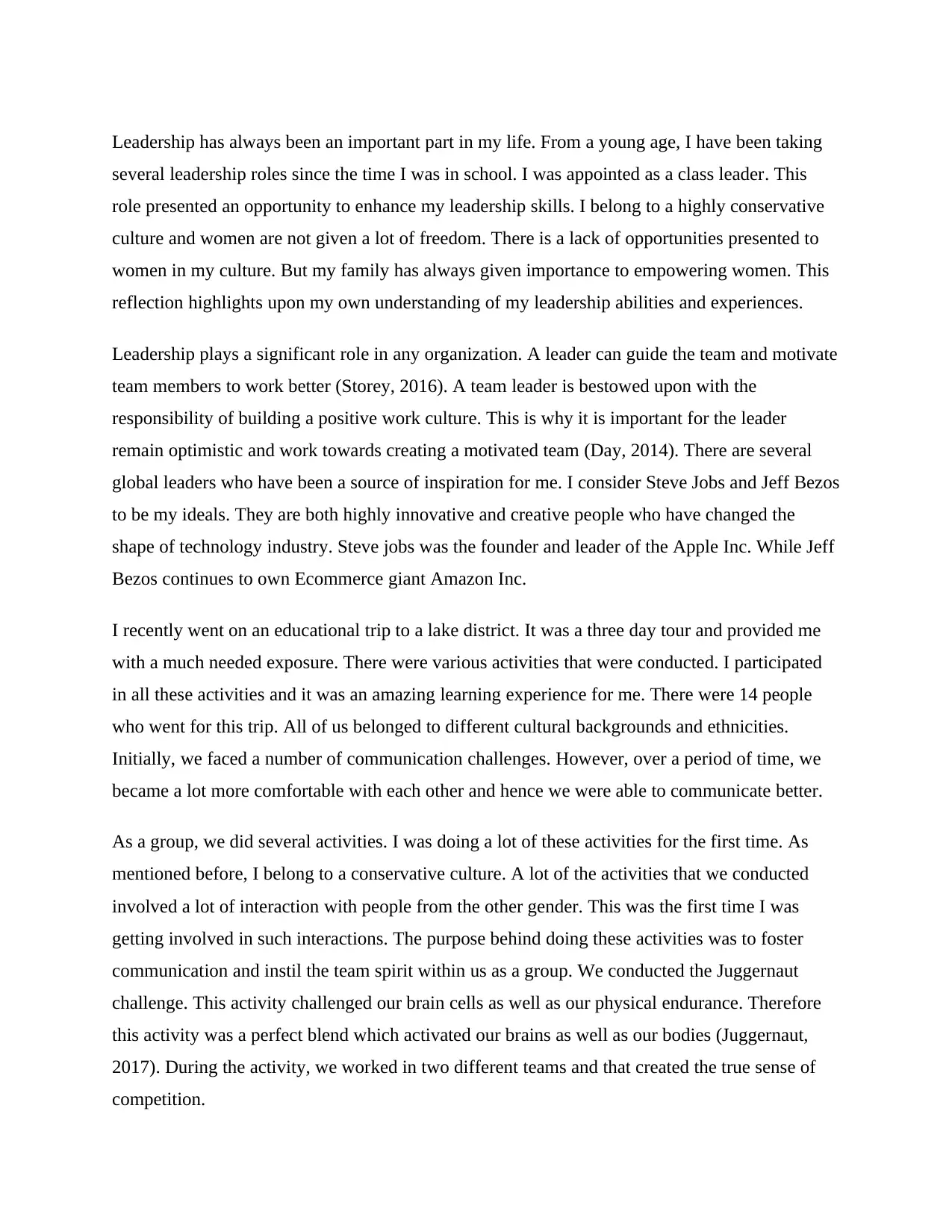
Leadership has always been an important part in my life. From a young age, I have been taking
several leadership roles since the time I was in school. I was appointed as a class leader. This
role presented an opportunity to enhance my leadership skills. I belong to a highly conservative
culture and women are not given a lot of freedom. There is a lack of opportunities presented to
women in my culture. But my family has always given importance to empowering women. This
reflection highlights upon my own understanding of my leadership abilities and experiences.
Leadership plays a significant role in any organization. A leader can guide the team and motivate
team members to work better (Storey, 2016). A team leader is bestowed upon with the
responsibility of building a positive work culture. This is why it is important for the leader
remain optimistic and work towards creating a motivated team (Day, 2014). There are several
global leaders who have been a source of inspiration for me. I consider Steve Jobs and Jeff Bezos
to be my ideals. They are both highly innovative and creative people who have changed the
shape of technology industry. Steve jobs was the founder and leader of the Apple Inc. While Jeff
Bezos continues to own Ecommerce giant Amazon Inc.
I recently went on an educational trip to a lake district. It was a three day tour and provided me
with a much needed exposure. There were various activities that were conducted. I participated
in all these activities and it was an amazing learning experience for me. There were 14 people
who went for this trip. All of us belonged to different cultural backgrounds and ethnicities.
Initially, we faced a number of communication challenges. However, over a period of time, we
became a lot more comfortable with each other and hence we were able to communicate better.
As a group, we did several activities. I was doing a lot of these activities for the first time. As
mentioned before, I belong to a conservative culture. A lot of the activities that we conducted
involved a lot of interaction with people from the other gender. This was the first time I was
getting involved in such interactions. The purpose behind doing these activities was to foster
communication and instil the team spirit within us as a group. We conducted the Juggernaut
challenge. This activity challenged our brain cells as well as our physical endurance. Therefore
this activity was a perfect blend which activated our brains as well as our bodies (Juggernaut,
2017). During the activity, we worked in two different teams and that created the true sense of
competition.
several leadership roles since the time I was in school. I was appointed as a class leader. This
role presented an opportunity to enhance my leadership skills. I belong to a highly conservative
culture and women are not given a lot of freedom. There is a lack of opportunities presented to
women in my culture. But my family has always given importance to empowering women. This
reflection highlights upon my own understanding of my leadership abilities and experiences.
Leadership plays a significant role in any organization. A leader can guide the team and motivate
team members to work better (Storey, 2016). A team leader is bestowed upon with the
responsibility of building a positive work culture. This is why it is important for the leader
remain optimistic and work towards creating a motivated team (Day, 2014). There are several
global leaders who have been a source of inspiration for me. I consider Steve Jobs and Jeff Bezos
to be my ideals. They are both highly innovative and creative people who have changed the
shape of technology industry. Steve jobs was the founder and leader of the Apple Inc. While Jeff
Bezos continues to own Ecommerce giant Amazon Inc.
I recently went on an educational trip to a lake district. It was a three day tour and provided me
with a much needed exposure. There were various activities that were conducted. I participated
in all these activities and it was an amazing learning experience for me. There were 14 people
who went for this trip. All of us belonged to different cultural backgrounds and ethnicities.
Initially, we faced a number of communication challenges. However, over a period of time, we
became a lot more comfortable with each other and hence we were able to communicate better.
As a group, we did several activities. I was doing a lot of these activities for the first time. As
mentioned before, I belong to a conservative culture. A lot of the activities that we conducted
involved a lot of interaction with people from the other gender. This was the first time I was
getting involved in such interactions. The purpose behind doing these activities was to foster
communication and instil the team spirit within us as a group. We conducted the Juggernaut
challenge. This activity challenged our brain cells as well as our physical endurance. Therefore
this activity was a perfect blend which activated our brains as well as our bodies (Juggernaut,
2017). During the activity, we worked in two different teams and that created the true sense of
competition.
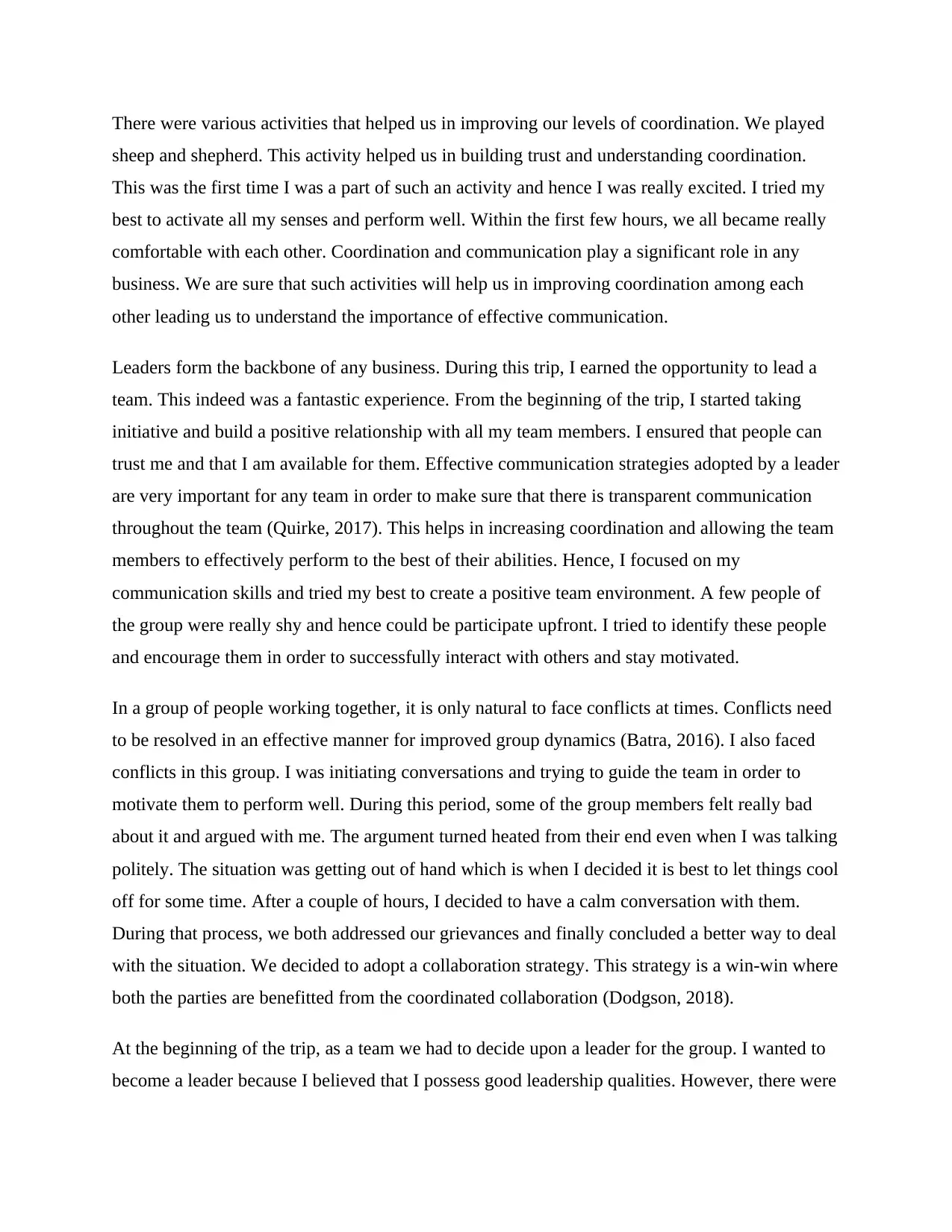
There were various activities that helped us in improving our levels of coordination. We played
sheep and shepherd. This activity helped us in building trust and understanding coordination.
This was the first time I was a part of such an activity and hence I was really excited. I tried my
best to activate all my senses and perform well. Within the first few hours, we all became really
comfortable with each other. Coordination and communication play a significant role in any
business. We are sure that such activities will help us in improving coordination among each
other leading us to understand the importance of effective communication.
Leaders form the backbone of any business. During this trip, I earned the opportunity to lead a
team. This indeed was a fantastic experience. From the beginning of the trip, I started taking
initiative and build a positive relationship with all my team members. I ensured that people can
trust me and that I am available for them. Effective communication strategies adopted by a leader
are very important for any team in order to make sure that there is transparent communication
throughout the team (Quirke, 2017). This helps in increasing coordination and allowing the team
members to effectively perform to the best of their abilities. Hence, I focused on my
communication skills and tried my best to create a positive team environment. A few people of
the group were really shy and hence could be participate upfront. I tried to identify these people
and encourage them in order to successfully interact with others and stay motivated.
In a group of people working together, it is only natural to face conflicts at times. Conflicts need
to be resolved in an effective manner for improved group dynamics (Batra, 2016). I also faced
conflicts in this group. I was initiating conversations and trying to guide the team in order to
motivate them to perform well. During this period, some of the group members felt really bad
about it and argued with me. The argument turned heated from their end even when I was talking
politely. The situation was getting out of hand which is when I decided it is best to let things cool
off for some time. After a couple of hours, I decided to have a calm conversation with them.
During that process, we both addressed our grievances and finally concluded a better way to deal
with the situation. We decided to adopt a collaboration strategy. This strategy is a win-win where
both the parties are benefitted from the coordinated collaboration (Dodgson, 2018).
At the beginning of the trip, as a team we had to decide upon a leader for the group. I wanted to
become a leader because I believed that I possess good leadership qualities. However, there were
sheep and shepherd. This activity helped us in building trust and understanding coordination.
This was the first time I was a part of such an activity and hence I was really excited. I tried my
best to activate all my senses and perform well. Within the first few hours, we all became really
comfortable with each other. Coordination and communication play a significant role in any
business. We are sure that such activities will help us in improving coordination among each
other leading us to understand the importance of effective communication.
Leaders form the backbone of any business. During this trip, I earned the opportunity to lead a
team. This indeed was a fantastic experience. From the beginning of the trip, I started taking
initiative and build a positive relationship with all my team members. I ensured that people can
trust me and that I am available for them. Effective communication strategies adopted by a leader
are very important for any team in order to make sure that there is transparent communication
throughout the team (Quirke, 2017). This helps in increasing coordination and allowing the team
members to effectively perform to the best of their abilities. Hence, I focused on my
communication skills and tried my best to create a positive team environment. A few people of
the group were really shy and hence could be participate upfront. I tried to identify these people
and encourage them in order to successfully interact with others and stay motivated.
In a group of people working together, it is only natural to face conflicts at times. Conflicts need
to be resolved in an effective manner for improved group dynamics (Batra, 2016). I also faced
conflicts in this group. I was initiating conversations and trying to guide the team in order to
motivate them to perform well. During this period, some of the group members felt really bad
about it and argued with me. The argument turned heated from their end even when I was talking
politely. The situation was getting out of hand which is when I decided it is best to let things cool
off for some time. After a couple of hours, I decided to have a calm conversation with them.
During that process, we both addressed our grievances and finally concluded a better way to deal
with the situation. We decided to adopt a collaboration strategy. This strategy is a win-win where
both the parties are benefitted from the coordinated collaboration (Dodgson, 2018).
At the beginning of the trip, as a team we had to decide upon a leader for the group. I wanted to
become a leader because I believed that I possess good leadership qualities. However, there were
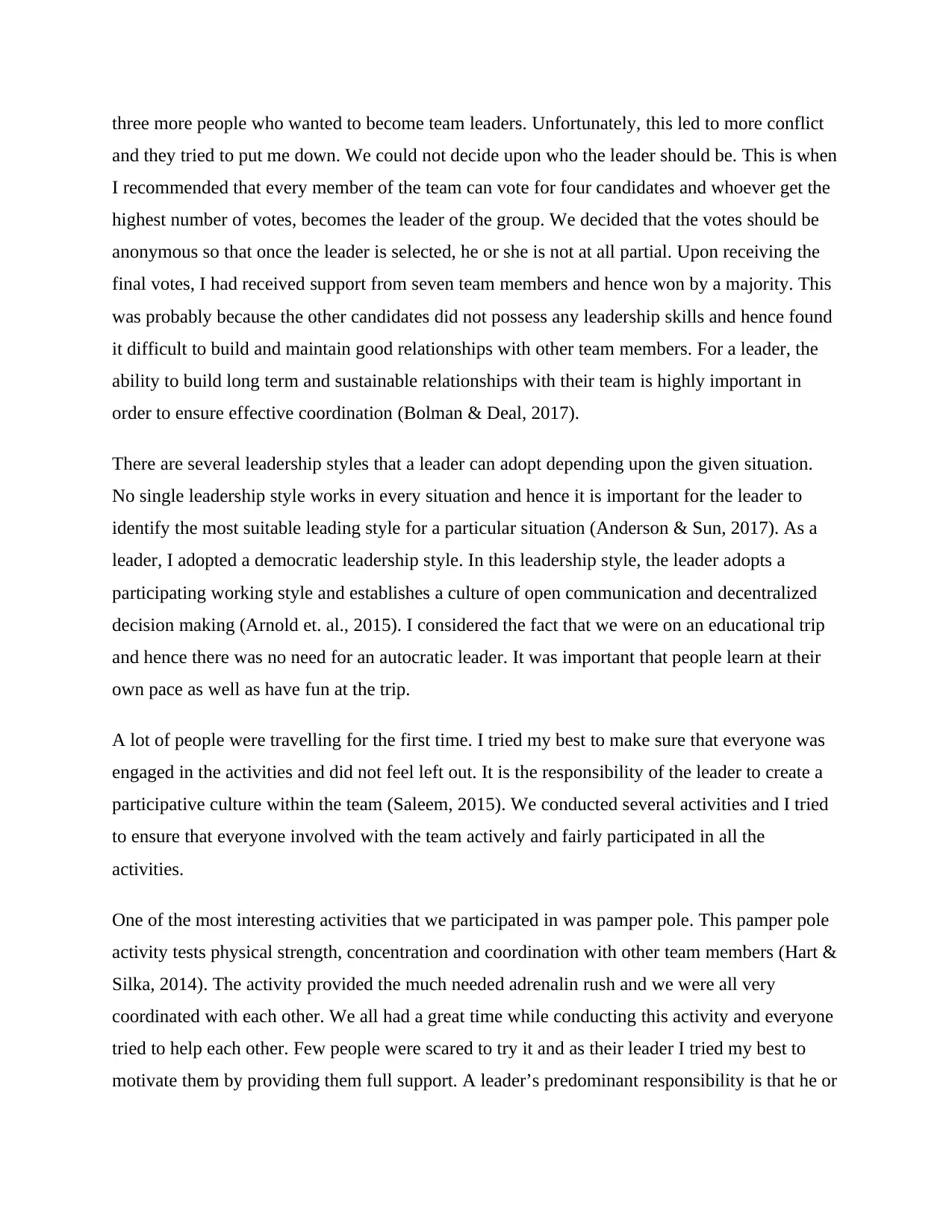
three more people who wanted to become team leaders. Unfortunately, this led to more conflict
and they tried to put me down. We could not decide upon who the leader should be. This is when
I recommended that every member of the team can vote for four candidates and whoever get the
highest number of votes, becomes the leader of the group. We decided that the votes should be
anonymous so that once the leader is selected, he or she is not at all partial. Upon receiving the
final votes, I had received support from seven team members and hence won by a majority. This
was probably because the other candidates did not possess any leadership skills and hence found
it difficult to build and maintain good relationships with other team members. For a leader, the
ability to build long term and sustainable relationships with their team is highly important in
order to ensure effective coordination (Bolman & Deal, 2017).
There are several leadership styles that a leader can adopt depending upon the given situation.
No single leadership style works in every situation and hence it is important for the leader to
identify the most suitable leading style for a particular situation (Anderson & Sun, 2017). As a
leader, I adopted a democratic leadership style. In this leadership style, the leader adopts a
participating working style and establishes a culture of open communication and decentralized
decision making (Arnold et. al., 2015). I considered the fact that we were on an educational trip
and hence there was no need for an autocratic leader. It was important that people learn at their
own pace as well as have fun at the trip.
A lot of people were travelling for the first time. I tried my best to make sure that everyone was
engaged in the activities and did not feel left out. It is the responsibility of the leader to create a
participative culture within the team (Saleem, 2015). We conducted several activities and I tried
to ensure that everyone involved with the team actively and fairly participated in all the
activities.
One of the most interesting activities that we participated in was pamper pole. This pamper pole
activity tests physical strength, concentration and coordination with other team members (Hart &
Silka, 2014). The activity provided the much needed adrenalin rush and we were all very
coordinated with each other. We all had a great time while conducting this activity and everyone
tried to help each other. Few people were scared to try it and as their leader I tried my best to
motivate them by providing them full support. A leader’s predominant responsibility is that he or
and they tried to put me down. We could not decide upon who the leader should be. This is when
I recommended that every member of the team can vote for four candidates and whoever get the
highest number of votes, becomes the leader of the group. We decided that the votes should be
anonymous so that once the leader is selected, he or she is not at all partial. Upon receiving the
final votes, I had received support from seven team members and hence won by a majority. This
was probably because the other candidates did not possess any leadership skills and hence found
it difficult to build and maintain good relationships with other team members. For a leader, the
ability to build long term and sustainable relationships with their team is highly important in
order to ensure effective coordination (Bolman & Deal, 2017).
There are several leadership styles that a leader can adopt depending upon the given situation.
No single leadership style works in every situation and hence it is important for the leader to
identify the most suitable leading style for a particular situation (Anderson & Sun, 2017). As a
leader, I adopted a democratic leadership style. In this leadership style, the leader adopts a
participating working style and establishes a culture of open communication and decentralized
decision making (Arnold et. al., 2015). I considered the fact that we were on an educational trip
and hence there was no need for an autocratic leader. It was important that people learn at their
own pace as well as have fun at the trip.
A lot of people were travelling for the first time. I tried my best to make sure that everyone was
engaged in the activities and did not feel left out. It is the responsibility of the leader to create a
participative culture within the team (Saleem, 2015). We conducted several activities and I tried
to ensure that everyone involved with the team actively and fairly participated in all the
activities.
One of the most interesting activities that we participated in was pamper pole. This pamper pole
activity tests physical strength, concentration and coordination with other team members (Hart &
Silka, 2014). The activity provided the much needed adrenalin rush and we were all very
coordinated with each other. We all had a great time while conducting this activity and everyone
tried to help each other. Few people were scared to try it and as their leader I tried my best to
motivate them by providing them full support. A leader’s predominant responsibility is that he or
Secure Best Marks with AI Grader
Need help grading? Try our AI Grader for instant feedback on your assignments.
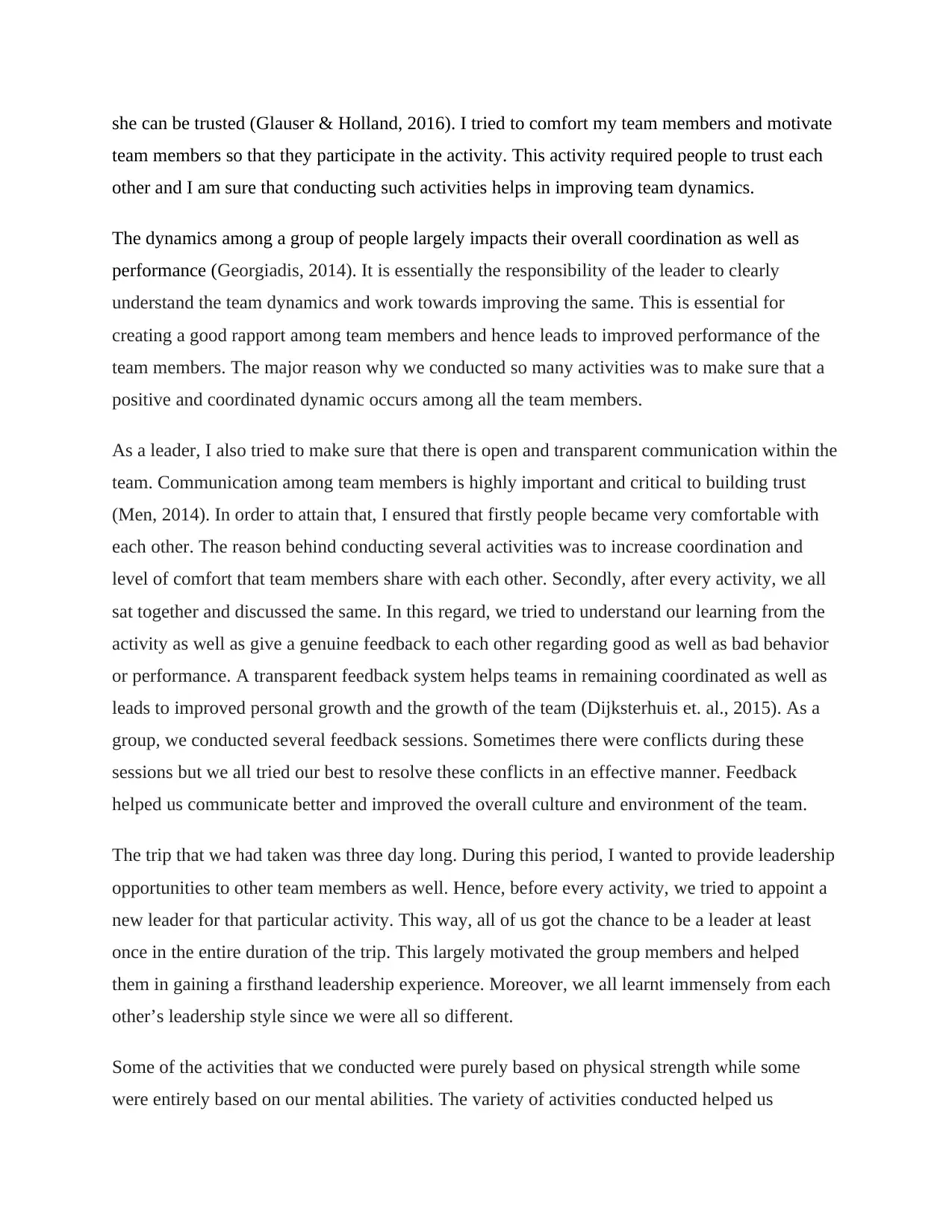
she can be trusted (Glauser & Holland, 2016). I tried to comfort my team members and motivate
team members so that they participate in the activity. This activity required people to trust each
other and I am sure that conducting such activities helps in improving team dynamics.
The dynamics among a group of people largely impacts their overall coordination as well as
performance (Georgiadis, 2014). It is essentially the responsibility of the leader to clearly
understand the team dynamics and work towards improving the same. This is essential for
creating a good rapport among team members and hence leads to improved performance of the
team members. The major reason why we conducted so many activities was to make sure that a
positive and coordinated dynamic occurs among all the team members.
As a leader, I also tried to make sure that there is open and transparent communication within the
team. Communication among team members is highly important and critical to building trust
(Men, 2014). In order to attain that, I ensured that firstly people became very comfortable with
each other. The reason behind conducting several activities was to increase coordination and
level of comfort that team members share with each other. Secondly, after every activity, we all
sat together and discussed the same. In this regard, we tried to understand our learning from the
activity as well as give a genuine feedback to each other regarding good as well as bad behavior
or performance. A transparent feedback system helps teams in remaining coordinated as well as
leads to improved personal growth and the growth of the team (Dijksterhuis et. al., 2015). As a
group, we conducted several feedback sessions. Sometimes there were conflicts during these
sessions but we all tried our best to resolve these conflicts in an effective manner. Feedback
helped us communicate better and improved the overall culture and environment of the team.
The trip that we had taken was three day long. During this period, I wanted to provide leadership
opportunities to other team members as well. Hence, before every activity, we tried to appoint a
new leader for that particular activity. This way, all of us got the chance to be a leader at least
once in the entire duration of the trip. This largely motivated the group members and helped
them in gaining a firsthand leadership experience. Moreover, we all learnt immensely from each
other’s leadership style since we were all so different.
Some of the activities that we conducted were purely based on physical strength while some
were entirely based on our mental abilities. The variety of activities conducted helped us
team members so that they participate in the activity. This activity required people to trust each
other and I am sure that conducting such activities helps in improving team dynamics.
The dynamics among a group of people largely impacts their overall coordination as well as
performance (Georgiadis, 2014). It is essentially the responsibility of the leader to clearly
understand the team dynamics and work towards improving the same. This is essential for
creating a good rapport among team members and hence leads to improved performance of the
team members. The major reason why we conducted so many activities was to make sure that a
positive and coordinated dynamic occurs among all the team members.
As a leader, I also tried to make sure that there is open and transparent communication within the
team. Communication among team members is highly important and critical to building trust
(Men, 2014). In order to attain that, I ensured that firstly people became very comfortable with
each other. The reason behind conducting several activities was to increase coordination and
level of comfort that team members share with each other. Secondly, after every activity, we all
sat together and discussed the same. In this regard, we tried to understand our learning from the
activity as well as give a genuine feedback to each other regarding good as well as bad behavior
or performance. A transparent feedback system helps teams in remaining coordinated as well as
leads to improved personal growth and the growth of the team (Dijksterhuis et. al., 2015). As a
group, we conducted several feedback sessions. Sometimes there were conflicts during these
sessions but we all tried our best to resolve these conflicts in an effective manner. Feedback
helped us communicate better and improved the overall culture and environment of the team.
The trip that we had taken was three day long. During this period, I wanted to provide leadership
opportunities to other team members as well. Hence, before every activity, we tried to appoint a
new leader for that particular activity. This way, all of us got the chance to be a leader at least
once in the entire duration of the trip. This largely motivated the group members and helped
them in gaining a firsthand leadership experience. Moreover, we all learnt immensely from each
other’s leadership style since we were all so different.
Some of the activities that we conducted were purely based on physical strength while some
were entirely based on our mental abilities. The variety of activities conducted helped us

improving and analyzing various aspects of our personalities. This essentially helped us in
identifying our weaknesses and working towards overcoming the same. One of the activities that
was conducted was number crunching. The aim of the exercise was to improve our ability to
calculate quickly and become proficient with the use of numbers. Unfortunately, since I was very
young, I have been very bad at math. I personally find it very difficult to do calculations in my
mind. This activity helped me understand that my calculations are really poor and I must work
upon them. Number crunching activity not only improves the ability to calculate but also
enhances the strategic ability of the brain to make fast decisions. Hence, I decided to work upon
this ability and practice number crunching at home in order to become better at conducting
calculations.
Different activities served different purposes. During one of the activities, we had to go through
a very complicated maze and reach the other side. A group of three members were supposed to
enter the maze together and coordinate among each other to successfully reach the other side.
The complexity of the maze was very high and we were given a limited time period to solve the
maze and reach the other side. It was interesting to note how people become impatient when they
are put under a timer and how some people manage to remain calm despite the situation. From
this activity I learnt that I tend to become highly impatient at times and hence end up losing my
temper. A calm temperament and the ability to make the right decision even in the face of
extreme pressure is an important leadership attribute (Brasfield, 2015). While working in
business organizations, the work pressure and close deadlines can often take a toll on the
decision making ability of a person. However, a sensible employee and an effective leader will
ensure that a calm temperament is maintained in order to make right decisions for accomplishing
team objectives.
Being successful feels great but an important aspect that I learnt through this trip is failing. We
conducted several activities in different teams. Everyone put their best foot forward in order to
win. However, there is always only one winner. It is important to understand that failing too, is
an art (Straehler-Pohl & Pais, 2014). Failing in an effective manner leads to learning as well as
personal growth of the person. Therefore it is imperative that individuals do not get demotivated
if they fail but rather learn from the same in order to improve themselves as people. This is
identifying our weaknesses and working towards overcoming the same. One of the activities that
was conducted was number crunching. The aim of the exercise was to improve our ability to
calculate quickly and become proficient with the use of numbers. Unfortunately, since I was very
young, I have been very bad at math. I personally find it very difficult to do calculations in my
mind. This activity helped me understand that my calculations are really poor and I must work
upon them. Number crunching activity not only improves the ability to calculate but also
enhances the strategic ability of the brain to make fast decisions. Hence, I decided to work upon
this ability and practice number crunching at home in order to become better at conducting
calculations.
Different activities served different purposes. During one of the activities, we had to go through
a very complicated maze and reach the other side. A group of three members were supposed to
enter the maze together and coordinate among each other to successfully reach the other side.
The complexity of the maze was very high and we were given a limited time period to solve the
maze and reach the other side. It was interesting to note how people become impatient when they
are put under a timer and how some people manage to remain calm despite the situation. From
this activity I learnt that I tend to become highly impatient at times and hence end up losing my
temper. A calm temperament and the ability to make the right decision even in the face of
extreme pressure is an important leadership attribute (Brasfield, 2015). While working in
business organizations, the work pressure and close deadlines can often take a toll on the
decision making ability of a person. However, a sensible employee and an effective leader will
ensure that a calm temperament is maintained in order to make right decisions for accomplishing
team objectives.
Being successful feels great but an important aspect that I learnt through this trip is failing. We
conducted several activities in different teams. Everyone put their best foot forward in order to
win. However, there is always only one winner. It is important to understand that failing too, is
an art (Straehler-Pohl & Pais, 2014). Failing in an effective manner leads to learning as well as
personal growth of the person. Therefore it is imperative that individuals do not get demotivated
if they fail but rather learn from the same in order to improve themselves as people. This is
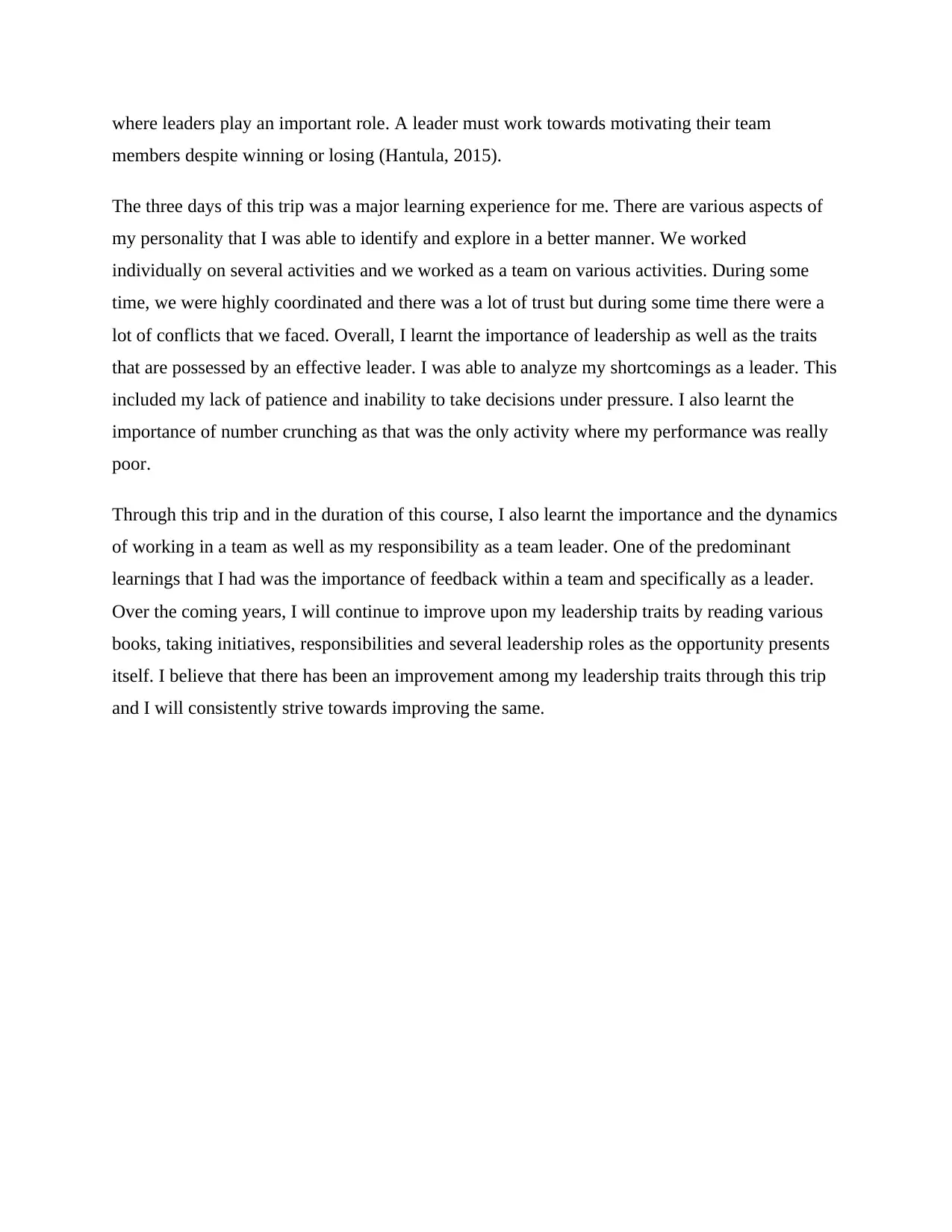
where leaders play an important role. A leader must work towards motivating their team
members despite winning or losing (Hantula, 2015).
The three days of this trip was a major learning experience for me. There are various aspects of
my personality that I was able to identify and explore in a better manner. We worked
individually on several activities and we worked as a team on various activities. During some
time, we were highly coordinated and there was a lot of trust but during some time there were a
lot of conflicts that we faced. Overall, I learnt the importance of leadership as well as the traits
that are possessed by an effective leader. I was able to analyze my shortcomings as a leader. This
included my lack of patience and inability to take decisions under pressure. I also learnt the
importance of number crunching as that was the only activity where my performance was really
poor.
Through this trip and in the duration of this course, I also learnt the importance and the dynamics
of working in a team as well as my responsibility as a team leader. One of the predominant
learnings that I had was the importance of feedback within a team and specifically as a leader.
Over the coming years, I will continue to improve upon my leadership traits by reading various
books, taking initiatives, responsibilities and several leadership roles as the opportunity presents
itself. I believe that there has been an improvement among my leadership traits through this trip
and I will consistently strive towards improving the same.
members despite winning or losing (Hantula, 2015).
The three days of this trip was a major learning experience for me. There are various aspects of
my personality that I was able to identify and explore in a better manner. We worked
individually on several activities and we worked as a team on various activities. During some
time, we were highly coordinated and there was a lot of trust but during some time there were a
lot of conflicts that we faced. Overall, I learnt the importance of leadership as well as the traits
that are possessed by an effective leader. I was able to analyze my shortcomings as a leader. This
included my lack of patience and inability to take decisions under pressure. I also learnt the
importance of number crunching as that was the only activity where my performance was really
poor.
Through this trip and in the duration of this course, I also learnt the importance and the dynamics
of working in a team as well as my responsibility as a team leader. One of the predominant
learnings that I had was the importance of feedback within a team and specifically as a leader.
Over the coming years, I will continue to improve upon my leadership traits by reading various
books, taking initiatives, responsibilities and several leadership roles as the opportunity presents
itself. I believe that there has been an improvement among my leadership traits through this trip
and I will consistently strive towards improving the same.
Paraphrase This Document
Need a fresh take? Get an instant paraphrase of this document with our AI Paraphraser

References
Anderson, M.H. and Sun, P.Y., 2017. Reviewing leadership styles: Overlaps and the need for a
new ‘full‐range’theory. International Journal of Management Reviews, 19(1), pp.76-96.
Arnold, K.A., Connelly, C.E., Walsh, M.M. and Martin Ginis, K.A., 2015. Leadership styles,
emotion regulation, and burnout. Journal of Occupational Health Psychology, 20(4), p.481.
Batra, S., 2016. Fighting for innovation: exploring the role of conflicts in enabling team
innovation. Strategic Direction, 32(1), pp.11-12.
Bolman, L.G. and Deal, T.E., 2017. Reframing organizations: Artistry, choice, and leadership.
John Wiley & Sons.
Brasfield, D.A., 2015. The effects of leadership traits in change management on operational
excellence (Doctoral dissertation, Capella University).
Day, D.V. ed., 2014. The Oxford handbook of leadership and organizations. Oxford Library of
Psychology.
Dijksterhuis, C., Lewis-Evans, B., Jelijs, B., de Waard, D., Brookhuis, K. and Tucha, O., 2015.
The impact of immediate or delayed feedback on driving behaviour in a simulated Pay-As-You-
Drive system. Accident Analysis & Prevention, 75, pp.93-104.
Dodgson, M., 2018. Technological collaboration in industry: strategy, policy and
internationalization in innovation. Routledge.
Georgiadis, G., 2014. Projects and team dynamics. The Review of Economic Studies, 82(1),
pp.187-218.
Glauser, M. and Holland, D., 2016. The Leadership Traits Shared by Successful
Entrepreneurs. Entrepreneur & Innovation Exchange.
Hantula, D.A., 2015. Job satisfaction: The management tool and leadership
responsibility. Journal of Organizational Behavior Management, 35(1-2), pp.81-94.
Anderson, M.H. and Sun, P.Y., 2017. Reviewing leadership styles: Overlaps and the need for a
new ‘full‐range’theory. International Journal of Management Reviews, 19(1), pp.76-96.
Arnold, K.A., Connelly, C.E., Walsh, M.M. and Martin Ginis, K.A., 2015. Leadership styles,
emotion regulation, and burnout. Journal of Occupational Health Psychology, 20(4), p.481.
Batra, S., 2016. Fighting for innovation: exploring the role of conflicts in enabling team
innovation. Strategic Direction, 32(1), pp.11-12.
Bolman, L.G. and Deal, T.E., 2017. Reframing organizations: Artistry, choice, and leadership.
John Wiley & Sons.
Brasfield, D.A., 2015. The effects of leadership traits in change management on operational
excellence (Doctoral dissertation, Capella University).
Day, D.V. ed., 2014. The Oxford handbook of leadership and organizations. Oxford Library of
Psychology.
Dijksterhuis, C., Lewis-Evans, B., Jelijs, B., de Waard, D., Brookhuis, K. and Tucha, O., 2015.
The impact of immediate or delayed feedback on driving behaviour in a simulated Pay-As-You-
Drive system. Accident Analysis & Prevention, 75, pp.93-104.
Dodgson, M., 2018. Technological collaboration in industry: strategy, policy and
internationalization in innovation. Routledge.
Georgiadis, G., 2014. Projects and team dynamics. The Review of Economic Studies, 82(1),
pp.187-218.
Glauser, M. and Holland, D., 2016. The Leadership Traits Shared by Successful
Entrepreneurs. Entrepreneur & Innovation Exchange.
Hantula, D.A., 2015. Job satisfaction: The management tool and leadership
responsibility. Journal of Organizational Behavior Management, 35(1-2), pp.81-94.
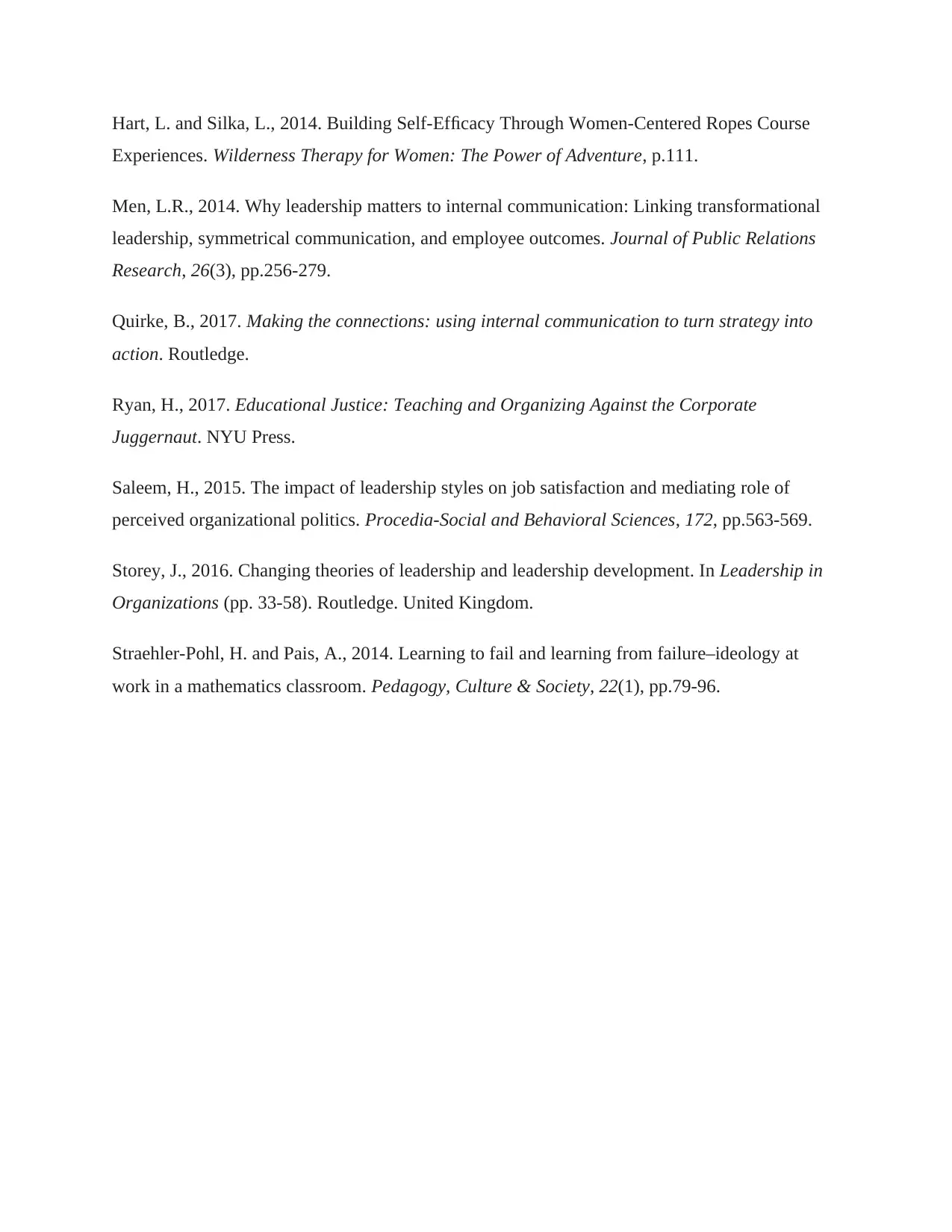
Hart, L. and Silka, L., 2014. Building Self-Efficacy Through Women-Centered Ropes Course
Experiences. Wilderness Therapy for Women: The Power of Adventure, p.111.
Men, L.R., 2014. Why leadership matters to internal communication: Linking transformational
leadership, symmetrical communication, and employee outcomes. Journal of Public Relations
Research, 26(3), pp.256-279.
Quirke, B., 2017. Making the connections: using internal communication to turn strategy into
action. Routledge.
Ryan, H., 2017. Educational Justice: Teaching and Organizing Against the Corporate
Juggernaut. NYU Press.
Saleem, H., 2015. The impact of leadership styles on job satisfaction and mediating role of
perceived organizational politics. Procedia-Social and Behavioral Sciences, 172, pp.563-569.
Storey, J., 2016. Changing theories of leadership and leadership development. In Leadership in
Organizations (pp. 33-58). Routledge. United Kingdom.
Straehler-Pohl, H. and Pais, A., 2014. Learning to fail and learning from failure–ideology at
work in a mathematics classroom. Pedagogy, Culture & Society, 22(1), pp.79-96.
Experiences. Wilderness Therapy for Women: The Power of Adventure, p.111.
Men, L.R., 2014. Why leadership matters to internal communication: Linking transformational
leadership, symmetrical communication, and employee outcomes. Journal of Public Relations
Research, 26(3), pp.256-279.
Quirke, B., 2017. Making the connections: using internal communication to turn strategy into
action. Routledge.
Ryan, H., 2017. Educational Justice: Teaching and Organizing Against the Corporate
Juggernaut. NYU Press.
Saleem, H., 2015. The impact of leadership styles on job satisfaction and mediating role of
perceived organizational politics. Procedia-Social and Behavioral Sciences, 172, pp.563-569.
Storey, J., 2016. Changing theories of leadership and leadership development. In Leadership in
Organizations (pp. 33-58). Routledge. United Kingdom.
Straehler-Pohl, H. and Pais, A., 2014. Learning to fail and learning from failure–ideology at
work in a mathematics classroom. Pedagogy, Culture & Society, 22(1), pp.79-96.
1 out of 9
Related Documents
Your All-in-One AI-Powered Toolkit for Academic Success.
+13062052269
info@desklib.com
Available 24*7 on WhatsApp / Email
![[object Object]](/_next/static/media/star-bottom.7253800d.svg)
Unlock your academic potential
© 2024 | Zucol Services PVT LTD | All rights reserved.





